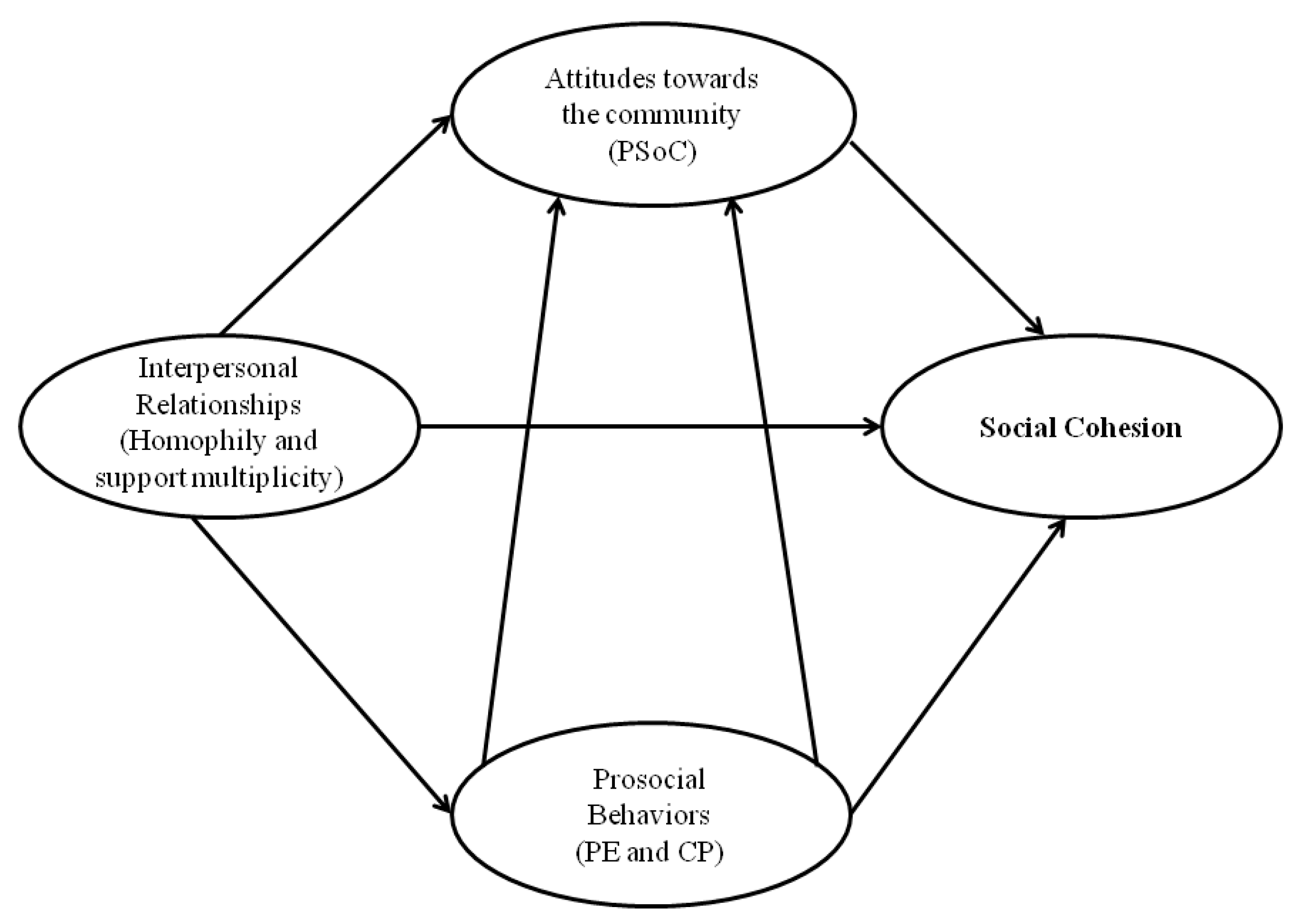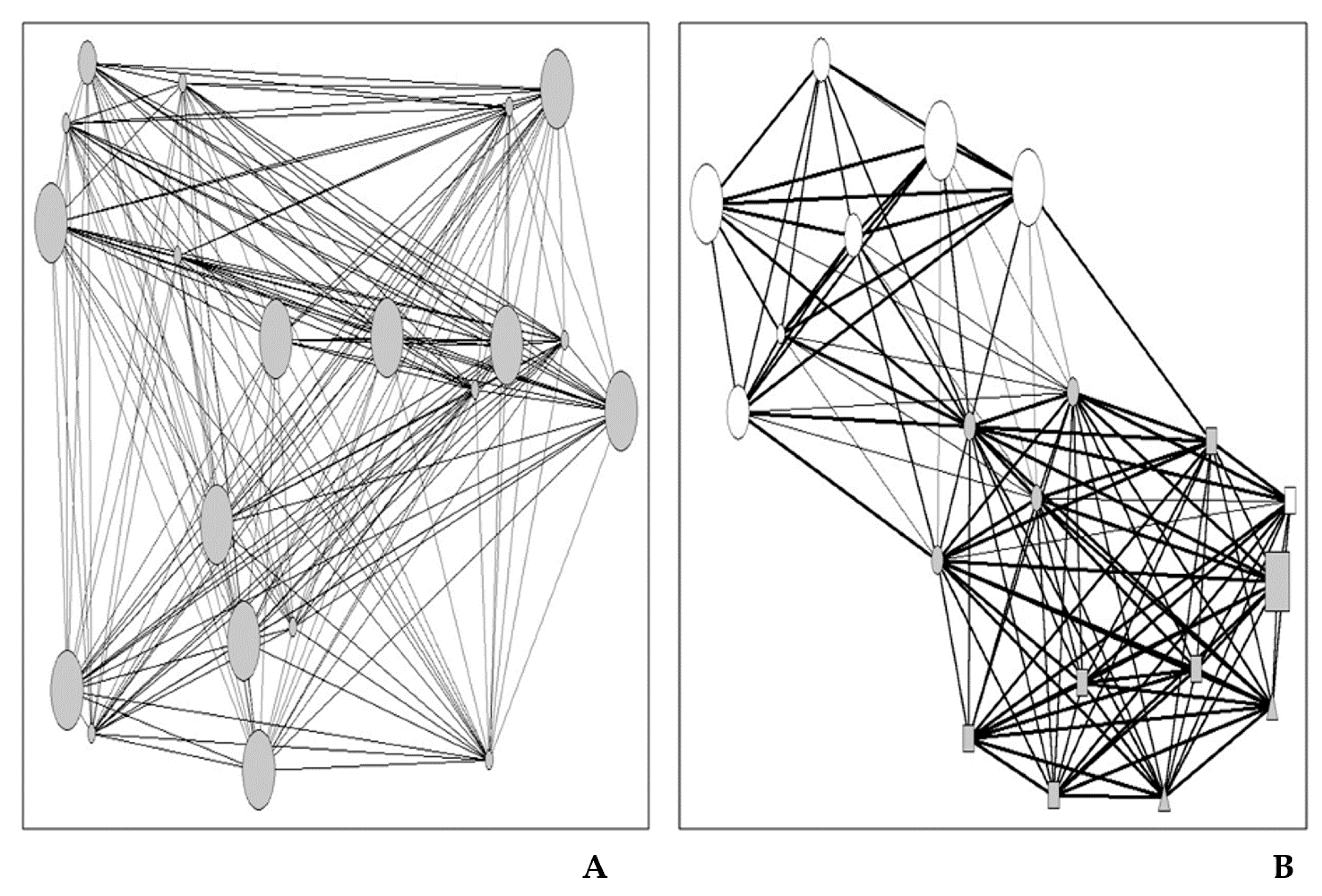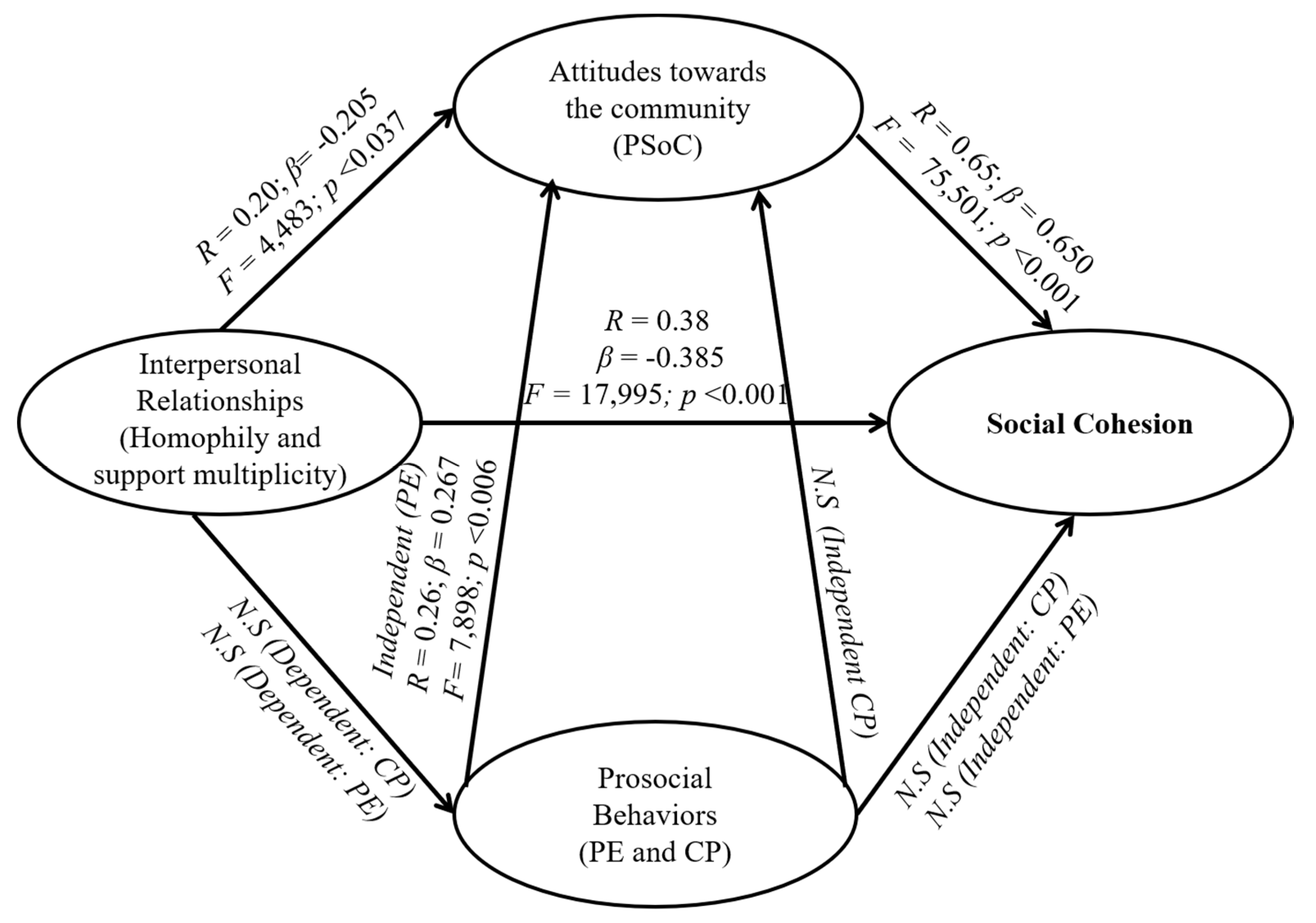Underlying Dimensions of Social Cohesion in a Rural Community Affected by Wartime Violence in Colombia
Abstract
1. Introduction
1.1. War and Psychosocial Processes
1.2. Fundamentals of Social Cohesion
1.3. Objectives
- Analyse the structure and composition of personal networks of members of a rural area affected by violence.
- Determine the effect that interpersonal relations, attitudinal factors (PSoC) and behavioural factors (CP and PE) produce in community cohesion. For this purpose, nine regression models (linear and multiple) were performed. Five regressions are developed to identify the associations between the independent variables (interpersonal relationships (homophily and support multiplicity), attitudes towards the community (PSoC) and prosocial behaviors (PE and CP)). While the rest of the models are proposed to examine the relationships between the independent variables and social cohesion.
1.4. Study Context
2. Materials and Methods
2.1. Participants and Sampling
2.2. Instruments
2.2.1. Independent Variables (Attitudinal and Behavioural)
2.2.2. Dependent Variable
2.3. Analysis of Data
3. Results
3.1. Characterization of Personal Networks (Objective 1)
3.2. The Incidence of Interpersonal Relationships, Attitudinal Factors (Psychological Sense of Community, PSoC) and Behavioural Factors (Community Participation, CP, and Psychological Empowerment, PE) in the Social Cohesion of the Community (Objective 2)
4. Discussion
5. Conclusions
- Understand the degree of cohesiveness within the communities is a crucial point to design and implement intervention programs adapted to the community structure.
- For improving the perceived well-being and quality of life in communities that have suffered severe violence episodes, it is essential to increase the connections of individuals with their social environment (i.e., membership), in turn activating prosocial behaviours (i.e., civic engagement) which are antecedents to promoting the acquisition of control over their lives (i.e., empowerment).
- Personal networks analysis is a promising method for capturing the individuals’ relational context. The structure and composition of personal networks offer valuables clues to identify the degree of integration of subjects in their communities.
- Homogeneous and highly cohesive personal networks provide bonding social capital and offer multiple kinds of social support to ego, but constrain the opportunities to establish inter-community relationships with heterogeneous groups (bridging social capital) which are basic to overcoming situations of vulnerability.
Author Contributions
Funding
Acknowledgments
Conflicts of Interest
References
- Cederman, L.-M.; Vogt, M. Dynamics and logics of civil war. J. Confl. Resolut. 2017, 61, 1992–2016. [Google Scholar] [CrossRef]
- Wood, E.J. Civil war: The wartime transformation of social networks. Annu. Rev. Political Sci. 2008, 11, 539–561. [Google Scholar] [CrossRef]
- Gilligan, M.J.; Pasquale, B.J.; Samii, C. Civil war and social cohesion: Lab-in-the-field evidence from Nepal. Am. J. Political Sci. 2014, 58, 604–619. [Google Scholar] [CrossRef]
- Osorio, F.E. Entre la supervivencia y la resistencia. Acciones colectivas de población rural en medio del conflicto armado colombiano. Cuad. Desarro. Rural 2001, 47, 55–80. [Google Scholar]
- Kienzler, H.; Locke, P. The effects of societal violence in war and post-war contexts. In The Palgrave Handbook of Sociocultural Perspectives on Global Mental Health; Palgrave Macmillan: London, UK; pp. 285–305.
- Jayawickreme, N.; Mootoo, C.; Fountain, C.; Rasmussen, A.; Jayawickreme, E.; Bertuccio, R.F. Post-conflict struggles as networks of problems: A network analysis of trauma, daily stressors and psychological distress among Sri Lankan war survivors. Soc. Sci. Med. 2017, 190, 119–132. [Google Scholar] [CrossRef] [PubMed]
- Hoover, A. Explaining the Form and Extent of Wartime Violence against Combatants: The Role of Armed Group Institutions and Ideologies; Department of Political Science, Yale University: New Haven, CT, USA, 2007. [Google Scholar]
- Kalyvas, S. The Logic of Violence in Civil War; Cambridge University Press: New York, NY, USA, 2006. [Google Scholar]
- Festinger, L. Informal social communication. Psychol. Rev. 1950, 57, 271–282. [Google Scholar] [CrossRef] [PubMed]
- Friedkin, N.E. Social cohesion. Annu. Rev. Sociol. 2004, 30, 409–425. [Google Scholar] [CrossRef]
- Gonzalez, J.A.; Ragins, B.R.; Ehrhardt, K.; Singh, R. Friends and Family: The role of relationships in community and workplace attachment. J. Bus. Psychol. 2018, 33, 89–104. [Google Scholar] [CrossRef]
- McMillan, D.W.; Chavis, D. Sense of community: A definition and theory. J. Community Psychol. 1986, 14, 6–23. [Google Scholar] [CrossRef]
- Schiefer, D.; van der Noll, J. The essentials of social cohesion: A literature review. Soc. Indic. Res. 2017, 132, 579–603. [Google Scholar] [CrossRef]
- Taló, C.; Mannarini, T.; Rochira, A. Sense of community and community participation: A meta-analytic review. Soc. Indic. Res. 2014, 117, 1–28. [Google Scholar] [CrossRef]
- Chavis, D.M.; Wandersman, A. Sense of community in the urban environment: A catalyst for participation and community development. Am. J. Community Psychol. 1990, 18, 55–81. [Google Scholar] [CrossRef]
- Christens, B.D.; Peterson, N.A.; Speer, P.W. Community participation and psychological empowerment: Testing reciprocal causality using a cross-lagged panel design and latent constructs. Health Educ. Behav. 2011, 38, 339–347. [Google Scholar] [CrossRef] [PubMed]
- Speer, P.W.; Jackson, C.; Peterson, N.A. The relationship between social cohesion and empowerment: Support and new implications for theory. Health Educ. Behav. 2001, 28, 716–732. [Google Scholar] [CrossRef] [PubMed]
- Zimmerman, M.A. Psychological empowerment: Issues and illustrations. Am. J. Community Psychol. 1995, 23, 581–599. [Google Scholar] [CrossRef] [PubMed]
- Forrest, R.; Kearns, A. Social cohesion, social capital and the neighbourhood. Urban Stud. 2001, 38, 2125–2143. [Google Scholar] [CrossRef]
- Sampson, R.J. Local friendship ties and community attachment in mass society: A multilevel systemic model. Am. Sociol. Rev. 1988, 53, 766–779. [Google Scholar] [CrossRef]
- Bidart, C.; Degenne, A.; Grossetti, M. Personal networks typologies: A structural approach. Soc. Netw. 2018, 54, 1–11. [Google Scholar] [CrossRef]
- Frank, K.A.; Yasumoto, J.Y. Linking action to social structure within a system: Social capital within and between subgroups. Am. J. Sociol. 1998, 104, 642–686. [Google Scholar] [CrossRef]
- McPherson, M.; Smith-Lovin, L.; Cook, J.M. Birds of a feather: Homophily in social networks. Annu. Rev. Sociol. 2001, 27, 415–444. [Google Scholar] [CrossRef]
- Reagans, R.; McEvily, B. Network Structure and knowledge transfer: The effects of cohesion and range. Adm. Sci. Q. 2003, 48, 240–267. [Google Scholar] [CrossRef]
- Van der Meer, T.; Tolsma, J. Ethnic diversity and its effects on social cohesion. Annu. Rev. Sociol. 2014, 40, 459–478. [Google Scholar] [CrossRef]
- Duncan, G. Los Señores de la Guerra: De Paramilitares, Mafiosos y Autodefensas en Colombia; Planeta: Bogotá, Spain, 2006. [Google Scholar]
- Ortega-Montes, J.E. Crítica a las políticas de desarrollo regional en Colombia en el marco de la globalización: El caso del departamento de Córdoba. Economía, Sociedad y Territorio 2008, 8, 282–312. [Google Scholar] [CrossRef]
- Chavis, D.M.; Lee, K.S.; Acosta, J.D. The sense of community (SCI) revised: The reliability and validity of the SCI-2. In Proceedings of the 2nd International Community Psychology Conference; Society for Community Research and Action: Lisbon, Portugal, 2008. [Google Scholar]
- Speer, P.W.; Peterson, N.A. Psychometric properties of an empowerment scale: Testing cognitive, emotional, and behavioral domains. Soc. Work Res. 2000, 24, 109–118. [Google Scholar] [CrossRef]
- Zimmerman, M.A.; Zahniser, J.H. Refinements of sphere specific measures of perceived control: Development of a sociopolitical control scale. J. Community Psychol. 1991, 19, 189–204. [Google Scholar] [CrossRef]
- Barrera, M. Distinctions between social support concepts, measures, and models. Am. J. Community Psychol. 1986, 14, 413–445. [Google Scholar] [CrossRef]
- McCarty, C. Structure in personal networks. J. Soc. Struct. 2002, 3, 1–20. [Google Scholar]
- Borgatti, S.P.; Everett, M.G.; Freeman, L. UCINET VI Version 1.0; Analytic Technologies: Natick, MA, USA, 2002. [Google Scholar]
- Moncada, S.; Llorens, C.; Navarro, A.; Kristensen, T.S. ISTAS21: Versión en lengua castellana del cuestionario psicosocial de Copenhague (COPSOQ). Arch. Prev. Riesgos Labor. 2005, 8, 18–29. [Google Scholar]
- Kaufman, L.; Rousseeuw, P.J. Finding Groups in Data: An Introduction to Cluster Analysis (Vol. 344); John Wiley & Sons, Inc.: Hoboken, NJ, USA, 2009; ISBN 9780471878766. [Google Scholar]
- Louch, H. Personal network integration: Transitivity and homophily in strong-tie relations. Soc. Netw. 2000, 22, 45–64. [Google Scholar] [CrossRef]
- Lozares, C.; Verd, J.M.; Cruz, I.; Barranco, O. Homophily and heterophily in personal networks. From mutual acquaintance to relationship intensity. Qual. Quant. 2014, 48, 2657–2670. [Google Scholar] [CrossRef]
- Mollenhorst, G.; Volker, B.; Flap, H. Changes in personal relationships: How social contexts affect the emergence and discontinuation of relationships. Soc. Netw. 2014, 37, 65–80. [Google Scholar] [CrossRef]
- Fu, Y.C.; Velema, T.A.; Hwang, J.S. Upward contacts in everyday life: Benefits of reaching hierarchical relations in ego-centered networks. Soc. Netw. 2018, 54, 266–278. [Google Scholar] [CrossRef]
- Ramos-Vidal, I.; Maya-Jariego, I. Sentido de comunidad, empoderamiento psicológico y participación ciudadana en trabajadores de organizaciones culturales. Psychosoc. Interv. 2014, 23, 169–176. [Google Scholar] [CrossRef]
- Macy, M.W.; Flache, A. The weakness of strong ties: Collective action failure in a highly cohesive group. In Evolution of Social Networks; Routledge: London, UK, 2013; pp. 27–52. [Google Scholar]
- Pillai, K.G.; Hodgkinson, G.P.; Kalyanaram, G.; Nair, S.R. The negative effects of social capital in organizations: A review and extension. Int. J. Manag. Rev. 2017, 19, 97–124. [Google Scholar] [CrossRef]
- Verdery, A.M.; Entwisle, B.; Faust, K.; Rindfuss, R.R. Social and spatial networks: Kinship distance and dwelling unit proximity in rural Thailand. Soc. Netw. 2012, 34, 112–127. [Google Scholar] [CrossRef]
- Brunton-Smith, I.A.N.; Sturgis, P.; Leckie, G. How collective is collective efficacy? The importance of consensus in judgments about community cohesion and willingness to intervene. Criminology 2018, in press. [Google Scholar] [CrossRef]
- Cramm, J.M.; Nieboer, A.P. Social cohesion and belonging predict the well-being of community-dwelling older people. BMC Geriatr. 2015, 15, 30. [Google Scholar] [CrossRef]
- Small, M.L.; Sukhu, C. Because they were there: Access, deliberation, and the mobilization of networks for support. Soc. Netw. 2016, 47, 73–84. [Google Scholar] [CrossRef]
- Vollhardt, J.R. Altruism born of suffering and prosocial behavior following adverse life events: A review and conceptualization. Soc. Justice Res. 2009, 22, 53–97. [Google Scholar] [CrossRef]
- Aiyer, S.M.; Zimmerman, M.A.; Morrel-Samuels, S.; Reischl, T.M. From broken windows to busy streets: A community empowerment perspective. Health Educ. Behav. 2015, 42, 137–147. [Google Scholar] [CrossRef]



| Indicator | Minimum | Maximum | Mean (M) | SD |
|---|---|---|---|---|
| Density | 0.33 | 1 | 0.96 | 0.11 |
| Number of ties | 126 | 380 | 366.6 | 37.35 |
| Transitivity | 21.62 | 100 | 95.12 | 12.57 |
| Centralization | 0 | 70.36 | 3.48 | 9.86 |
| Number of subgroups | 1 | 5 | 1.31 | 0.70 |
| Multiplicity of social support | 0 | 4 | 1.4 | 0.82 |
| Homophily depending on the place of residence | −1 | 0.55 | −0.52 | 0.50 |
| Homophily according to sex | −1 | 0.17 | −0.1 | 0.22 |
| Homophily depending on the type of relationship | −1 | 0.55 | −0.16 | 0.42 |
| Average length of ego-alter relationship (years) | 1 | 48.25 | 23.03 | 10.15 |
| Variable | Cluster 1 (n = 43) | Cluster 2 (n = 62) |
|---|---|---|
| Final Centres | Final Centres | |
| Homophily based on the type of relationship | −0.31 | −0.06 |
| Homophily based on the place of residence | −0.59 | −0.49 |
| Duration of the ego-alter relationship | 33.15 | 16.03 |
| Variables | 1 | 2 | 3 | 4 | 5 | 6 | 7 | 8 | 9 | 10 |
|---|---|---|---|---|---|---|---|---|---|---|
| 1. Social cohesion | ||||||||||
| 2. Satisfaction (PSoC) | 0.52 * | |||||||||
| 3. Membership (PSoC) | 0.48 * | 0.47 * | ||||||||
| 4. Influence (PSoC) | 0.47 * | 0.41 * | 0.54 * | |||||||
| 5. Connection (PSoC) | 0.58 * | 0.38 * | 0.53 * | 0.55 * | ||||||
| 6. Complete PSoC | 0.65 * | 0.72 * | 0.79 * | 0.82 * | 0.78 * | |||||
| 7. PE | 0.03 | 0.01 | 0.24 ** | 0.35 * | 0.17 | 0.26 * | ||||
| 8. CP | −0.01 | 0.04 | 0.05 | 0.16 | 0.01 | 0.09 | 0.41 * | |||
| 9. Residence homophily | −0.38 * | −0.33 * | −0.07 | −0.09 | −0.15 | −21 * | 0.01 | −0.10 | ||
| 10. Multiplicity | −0.12 | −0.02 | −0.02 | −0.10 | −0.10 | −0.03 | 0.06 | 0.08 | −0.32 * |
© 2019 by the authors. Licensee MDPI, Basel, Switzerland. This article is an open access article distributed under the terms and conditions of the Creative Commons Attribution (CC BY) license (http://creativecommons.org/licenses/by/4.0/).
Share and Cite
Ramos-Vidal, I.; Villamil, I.; Uribe, A. Underlying Dimensions of Social Cohesion in a Rural Community Affected by Wartime Violence in Colombia. Int. J. Environ. Res. Public Health 2019, 16, 195. https://doi.org/10.3390/ijerph16020195
Ramos-Vidal I, Villamil I, Uribe A. Underlying Dimensions of Social Cohesion in a Rural Community Affected by Wartime Violence in Colombia. International Journal of Environmental Research and Public Health. 2019; 16(2):195. https://doi.org/10.3390/ijerph16020195
Chicago/Turabian StyleRamos-Vidal, Ignacio, Ilse Villamil, and Alicia Uribe. 2019. "Underlying Dimensions of Social Cohesion in a Rural Community Affected by Wartime Violence in Colombia" International Journal of Environmental Research and Public Health 16, no. 2: 195. https://doi.org/10.3390/ijerph16020195
APA StyleRamos-Vidal, I., Villamil, I., & Uribe, A. (2019). Underlying Dimensions of Social Cohesion in a Rural Community Affected by Wartime Violence in Colombia. International Journal of Environmental Research and Public Health, 16(2), 195. https://doi.org/10.3390/ijerph16020195





